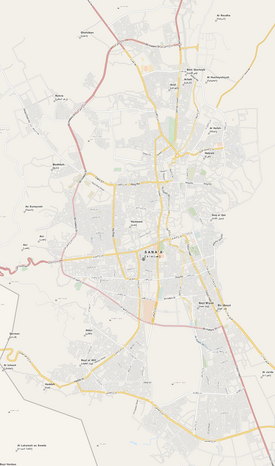
Back الجامع الكبير (صنعاء) Arabic الجامع القديم (صنعا, اليمن) ARZ সানার বড় মসজিদ Bengali/Bangla Gran mesquita de Sanà Catalan Große Moschee von Sanaa German Gran Mezquita de Saná Spanish مسجد اعظم صنعا Persian Grande Mosquée de Sanaa French Babban Masallacin Sana'a Hausa सना की महान मस्जिद Hindi
| Great Mosque of Sanaa al-Jāmiʿ al-Kabīr bi-Ṣanʿāʾ | |
|---|---|
الجامع الكبير بصنعاء | |
 | |
| Religion | |
| Affiliation | Islam |
| Province | Amanat Al-Asemah |
| Rite | Zaydism |
| Ecclesiastical or organizational status | In use |
| Leadership | Initially Muhammad and later Umayyad caliph al-Walid I |
| Year consecrated | 7th–8th century |
| Status | Active |
| Location | |
| Location | Yemen |
| Municipality | Sanaa |
| Geographic coordinates | 15°21′11″N 44°12′54″E / 15.3531°N 44.2149°E |
| Architecture | |
| Type | Mosque |
| Style | Yemeni |
| Groundbreaking | 630 AD |
| Completed | Renovation 705 and 715 AD |
| Specifications | |
| Length | 80 m |
| Width | 60 m |
| Minaret(s) | Two |
| Materials | Brick and stone |
| Part of | Old City of Sana'a |
| Criteria | Cultural: iv, v, vi |
| Reference | 385 |
| Inscription | 1986 (10th Session) |
| Endangered | 2015 - Present |
The Great Mosque of Sana'a (Arabic: الجامع الكبير بصنعاء, al-Jāmiʿ al-Kabīr bi-Ṣanʿāʾ) is an ancient mosque in Sana'a, Yemen, and one of the oldest mosques in the world.[1] The mosque is said to have been founded in the early Islamic period, suggested to be in 633.[2][3][4][5] While the precise date of construction is unknown, the earliest recorded renovations occurred under Caliph al-Walid I in the early 8th century, implying a possible earlier date of construction.[4] The mosque was reportedly built in part from spolia from the Himyarite-era Ghumdan Palace and from the Axumite Christian Church of al-Qalis that formerly occupied the site.[1][4] The Great Mosque is the largest and most notable of over one hundred mosques in the Old City of Sana’a.[3]
The building has undergone renovations in the 8th century, the 13th century, and during the Ottoman period.[1] An important archaeological find was the Sana'a manuscript, discovered there during restoration in 1972. Today, the Great Mosque of Sana’a is part of the UNESCO World Heritage Site of the Old City of Sana'a.[5]
- ^ a b c "World Heritage Institute of Training and Research-Asia and Pacific - Restoration of the Great Mosque in Sana'a, Yemen". www.whitr-ap.org. Retrieved 2020-12-09.
- ^ al-Mad'aj, 'Abd al-Muhsin (1994). New Arabian Studies Volume 1. University of Exeter Press. pp. 175–188. ISBN 9780859894081.
- ^ a b Smith, G.R., “Ṣanʿāʾ”, in: Encyclopaedia of Islam, Second Edition, Edited by: P. Bearman, Th. Bianquis, C.E. Bosworth, E. van Donzel, W.P. Heinrichs. Consulted online on 08 December 2020 doi:10.1163/1573-3912_islam_COM_0998 First published online: 2012 First print edition: ISBN 9789004161214, 1960-2007
- ^ a b c Cite error: The named reference
:5was invoked but never defined (see the help page). - ^ a b "Old City of Sana'a". UNESCO World Heritage Centre. Retrieved 2020-12-09.
